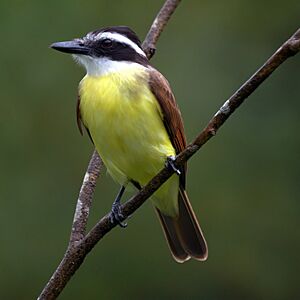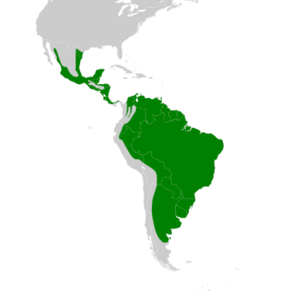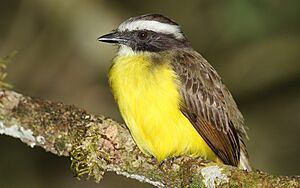Great kiskadee facts for kids
Quick facts for kids Great kiskadee |
|
|---|---|
 |
|
| Conservation status | |
| Scientific classification | |
| Genus: |
Pitangus
|
| Species: |
sulphuratus
|
 |
|
| Synonyms | |
|
|
The great kiskadee (Pitangus sulphuratus) is a colorful passerine bird. It belongs to the tyrant flycatcher family, Tyrannidae. This bird is special because it's the only member of its group, called Pitangus.
People in different countries have given it fun names. In Brazil, it's called bem-te-vi, which means "I saw you well." In Argentina, it's benteveo or bichofeo. It's also known as pitogue in Paraguay and luis bienteveo in Mexico.
Great kiskadees live in open woodlands with tall trees. You can also find them near farms and in towns. They are common in Belize, southern Texas, and northern Mexico. They live all the way from Brazil and Venezuela south to Argentina and Uruguay. Some were even brought to Bermuda in 1957 and Tobago around 1970.
Contents
About the Great Kiskadee's Name
The great kiskadee got its scientific name from a Swedish scientist named Carl Linnaeus in 1766. He called it Lanius sulphuratus. The word sulphuratus is Latin for 'sulphur', which describes the bird's bright yellow belly.
This bird is the only species in the group Pitangus. This group was named by an English naturalist, William Swainson, in 1827.
Where Great Kiskadees Live
There are 10 different types, or subspecies, of the great kiskadee. They live in various parts of North and South America:
- P. s. texanus – from south Texas to east Mexico
- P. s. derbianus – west Mexico
- P. s. guatimalensis – from southeast Mexico to central Panama
- P. s. rufipennis – north Colombia and north Venezuela
- P. s. caucensis – west and south Colombia
- P. s. trinitatis – east Colombia, south and east Venezuela, northwest Brazil, and Trinidad
- P. s. sulphuratus – the Guianas, north, west, central Amazonian Brazil, southeast Colombia, and east Ecuador to southeast Peru
- P. s. maximiliani – north, east Bolivia, west, central Paraguay, and east, south Brazil
- P. s. bolivianus – central Bolivia
- P. s. argentinus – east Paraguay, southeast Brazil, Uruguay, and central Argentina
What Great Kiskadees Look Like
The great kiskadee is one of the biggest tyrant flycatchers. It is about 25 to 28 centimeters (10 to 11 inches) long. It weighs between 53 and 71.5 grams (about 1.9 to 2.5 ounces).
Its head is black with a bold white stripe above its eye. It also has a hidden yellow stripe on its crown. The top part of its body is brown. Its wings and tail are brown with reddish-brown edges. It has a short, thick, black beak.
Great Kiskadee's Call
The great kiskadee is known for its loud and cheerful call. It sounds like BEE-tee-WEE. This call is why it has its onomatopoeic names in other languages. For example, bem-te-vi in Brazil and bien-te-veo in Spanish-speaking countries. In Venezuela, some people call it "cristofué," meaning "Christ did it."
Where Great Kiskadees Live and Their Homes
Great kiskadees live in many different places. They can be found from open grasslands with a few trees to busy city areas. Their home range stretches from southern Texas all the way down through Central America to southern Argentina. They do not live in Chile.
In 1957, 200 great kiskadees were brought to Bermuda from Trinidad. This was an attempt to control the number of lizards there. By 1976, the bird population had grown to about 60,000. However, the kiskadees eat many different things, so they didn't really help control the lizards.
Great Kiskadee Behavior and Diet
The great kiskadee is a very common and noisy bird. It is almost an omnivore, meaning it eats nearly everything. It hunts like a shrike or a flycatcher. It waits on a high branch and then flies out to catch insects in the air. It also pounces on small animals like rodents, other birds' chicks, and even bats.
They also find food on plants. They eat small snakes, lizards, frogs, spiders, and snails. They also enjoy some seeds and fruit. Sometimes, they even dive into shallow water to catch freshwater snails, fish, or tadpoles. This makes them one of the few fishing passerines. They also visit bird feeders for bread, bananas, and peanut butter.
Kiskadees usually hunt alone or in pairs. They are very alert and aggressive birds. They have strong, quick flights. They use this to chase away larger birds like raptors. They will dive at them and make loud calls to warn other animals. This often makes the raptors leave.
Great Kiskadee Reproduction
Great kiskadees stay with one partner and protect their nesting area. Both the male and female build a large, dome-shaped nest. It has an entrance on the side. They mostly use grasses and small twigs. They might also use lichen, string, or even plastic. Sometimes, they even steal materials from other birds' nests!
They build their nests in many different spots. Often, it's high up in a tree or on human-made structures. Sometimes, they build nests inside a hole or cavity.
The female lays 3 to 4 eggs. The eggs are light yellowish-cream with purplish-black and purplish-brown spots. They are about 27.9 x 20.0 millimeters (1.1 x 0.8 inches) in size. Only the female sits on the eggs to keep them warm. The male guards the nest while she goes to find food. The eggs hatch after 16 to 17 days. Both parents feed the baby birds. The young birds leave the nest after 17 to 18 days.

Great Kiskadee Status
The great kiskadee is not usually kept as a pet because it's not a songbird. Also, it's very hard to keep them in cages since they mostly eat live prey. Because of this, they are not often caught for the pet trade. The IUCN says that the great kiskadee is not a threatened species. This means their numbers are healthy in the wild.
Images for kids








